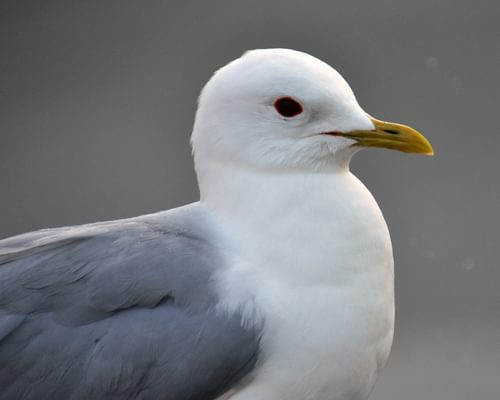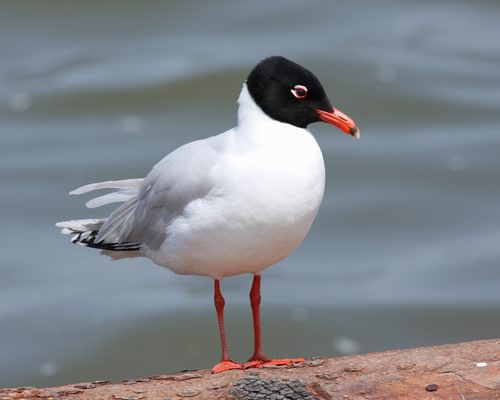Black-headed Gull
Least ConcernLarus ridibundus
Visual Identification
Appearance
The Black-headed Gull exhibits a striking seasonal transformation. In summer, it sports a dark chocolate-brown hood, contrasting sharply with its white body, pale grey wings, bright red bill and legs. The wingtips are black, creating a distinctive pattern in flight.
The dark hood disappears during winter, replaced by a white head with a dark ear spot. Juveniles have brown-mottled wings and a dark terminal tail band, gradually acquiring adult plumage over several years.
Size
Length
38cm to 44cm
Wingspan
94cm to 105cm
Weight
200g to 400g
Colours
Males and females have similar plumage
Primary Colour
White Grey
Secondary Colour
Black Brown
Beak Colour
Red
Leg Colour
Red
Habitat and Distribution
Habitats
Woodland
Garden
Wetland
Coastal
Urban
Farmland
Grassland
Desert
Tundra
Rainforest
Mountain
Savanna
Distribution
Black-headed Gulls are widely distributed across Europe and Asia, with some populations in eastern North America. They thrive in various aquatic habitats, including coastal areas, estuaries, lakes, and rivers. During the breeding season, they prefer inland freshwater bodies.
In winter, many birds move to coastal regions, with significant populations in the UK, Ireland, and other parts of Western Europe. They've also adapted well to urban environments, becoming common in city parks and harbors.
Elevation Range
Up to 1,000 meters
Climate zones
Temperate, Subarctic
Distribution Map
This map gives you a rough idea of where you might spot a Black-headed Gull. The coloured areas show countries where these birds have been seen.
A few things to keep in mind:
- Birds might not be everywhere in the coloured areas, for example, they may be present around the coast of that country
- Where birds live can change with seasons and available food
- This map is quite simple - it doesn't show exact locations
We're working on making our maps even better! Soon, we hope to show you:
- More detailed maps for bigger countries, including state and region
- How birds move around during different seasons
Distribution by Region
Behaviour and Ecology
Bird Attributes
This feature is in beta. We'd love your feedback to improve it!
Share your thoughtsBird Attributes Explained
Our bird attributes system rates various aspects of a bird's capabilities on a scale of 0-100, based on data from field observations, scientific studies, and expert knowledge.
Attribute Categories:
- Agility: Manoeuvrability, speed, and grace in flight or movement.
- Strength: Physical power, often correlating with size and hunting abilities.
- Adaptability: Ability to thrive in various environments or changing conditions.
- Aggressiveness: Territorial behaviour and assertiveness, particularly during breeding seasons.
- Endurance: Stamina, often seen in migration patterns or foraging behaviours.
Understanding the Ratings:
- 0-20: Very Low
- 21-40: Low
- 41-60: Average
- 61-80: High
- 81-100: Very High
Remember, these attributes are relative to other bird species and don't necessarily indicate superiority.
Hover over the icon next to each attribute for more information.
Tap the icon next to each attribute for more information.
Agility
Reflects the bird's manoeuvrability, speed, and grace in flight or movement.
The Black-headed Gull demonstrates remarkable agility, particularly in flight. Their ability to catch insects mid-air and skilfully pluck food from water surfaces showcases their nimble nature. Their adept manoeuvrability in various environments, from coastal winds to urban settings, further supports this high agility rating.
Strength
Indicates the bird's physical power, often correlating with size and hunting abilities.
While not exceptionally strong for their size, Black-headed Gulls possess moderate strength. Their ability to navigate diverse habitats, from windswept shorelines to urban areas, and to carry nesting materials suggests a reasonable level of strength. However, they are not known for tackling large prey or performing feats requiring extraordinary power.
Adaptability
Represents the bird's ability to thrive in various environments or changing conditions.
Black-headed Gulls excel in adaptability. Their presence in varied habitats, from coastal areas to urban parks, and their diverse diet, including both natural prey and human food waste, demonstrate exceptional adaptability. Their ability to thrive in changing environments and exploit new food sources is particularly noteworthy.
Aggressiveness
Measures the bird's territorial behaviour and assertiveness, particularly during breeding seasons.
These gulls display moderate to high aggressiveness, particularly during breeding season. Their behaviour in large, noisy colonies and their ability to compete for food in urban environments indicate a assertive nature. However, they are not considered exceptionally aggressive compared to some other gull species.
Endurance
Reflects the bird's stamina, often seen in migration patterns or foraging behaviours.
Black-headed Gulls show good endurance, evidenced by their partial migratory behaviour and ability to thrive in diverse climates. Their capacity to forage extensively and maintain activity in various weather conditions supports this rating. While not extreme long-distance migrants, their adaptability to different environments suggests solid endurance.
Diet
Black-headed Gulls are opportunistic feeders with a diverse diet. They consume small fish, insects, worms, and crustaceans, often following ploughs to catch invertebrates.
In urban areas, they readily scavenge human food waste, demonstrating their adaptability to various food sources.
Behaviour
Black-headed Gulls are highly social, often seen in large, noisy flocks. They exhibit remarkable agility in flight, skilfully catching insects mid-air or plucking food from the water's surface.
These adaptable birds have also become adept at urban foraging, frequenting parks and scavenging from human food sources.
Vocalisation
Black-headed Gulls are vocal birds, known for their raucous 'kree-ar' call, often heard in large breeding colonies.
They also produce various other sounds, including a sharp 'kek-kek-kek' alarm call and softer 'mewing' notes during courtship and pair bonding.
Nesting & Breeding
Black-headed Gulls typically breed in large, noisy colonies from April to July. Courtship involves elaborate displays, including head-bobbing and mewing calls. Pairs often reunite in subsequent breeding seasons.
Nests are built on the ground near water, constructed from vegetation and lined with softer materials. Females lay 2-3 olive-brown eggs with dark splotches, well-camouflaged against predators.
Both parents incubate the eggs for about 23-26 days. Chicks fledge after 35-40 days but remain dependent on their parents for several more weeks, learning crucial foraging skills.
Lifespan
The Black-headed Gull typically lives for 10 to 15 years, with a maximum recorded lifespan of 32.9 years.
Like all birds, lifespan can be affected by factors including predation, habitat quality, disease, and access to food sources.
Conservation and Status
Global Conservation Status
While currently listed as Least Concern, Black-headed Gulls face threats from habitat loss, particularly in coastal breeding areas. Climate change and pollution also pose risks.
Conservation efforts focus on protecting wetland habitats and managing urban interactions to ensure population stability.
Population Data
Global Population Estimate
4,800,000 - 8,900,000 mature individuals [3]
Global Population Trend
Trend data may be uncertain or fluctuating
Birdwatching Tips
- Look for large flocks in coastal areas, especially during winter
- In urban areas, check parks and waterbodies for these adaptable gulls
- Listen for their distinctive 'kree-ar' call, especially in breeding colonies
- Observe their agile flight and feeding behavior over water
Additional Information
Quick Facts
Other names:
Common Black-headed Gull
Family:
LaridaePredators
Did You Know?
- Despite their name, Black-headed Gulls actually have chocolate-brown heads during the breeding season.
- They can drink fresh and salt water, thanks to special glands that excrete excess salt.
- These gulls have been observed 'paddling' their feet on the ground to imitate rainfall and bring worms to the surface.
Was this bird profile helpful?
Your feedback helps us improve our content
Thanks for your feedback!
Your input helps us improve our content.
Community Experience
Community Ratings
No ratings yet - be the first to rate this bird!
Latest Community Reviews
No reviews yet
Sign in to be the first to review
Community Reviews
Create Your Free Account Welcome Back!
Join our community to rate birds and share your experiences. Creating an account is completely free and only takes a minute. Sign in to your account to rate birds and share your experiences with our community.
Your information is secure and will never be shared.
By creating an account, you agree to our Privacy Policy.
Similar Birds
References
- 2
website: BirdLife International. 2018. Larus ridibundus. The IUCN Red List of Threatened Species 2018: e.T22694420A132548687.
View source - 1 3
report, 2015: Wetlands International

